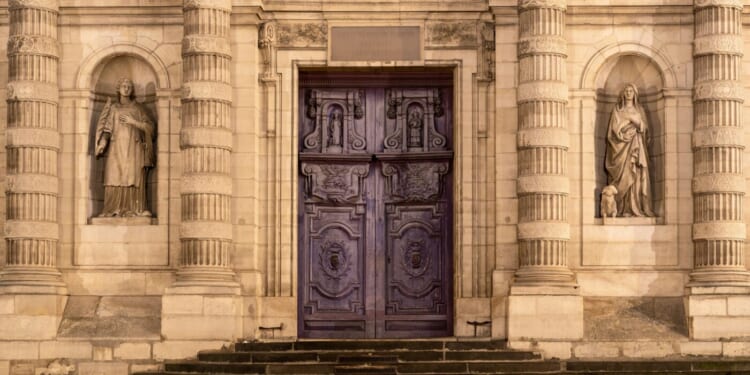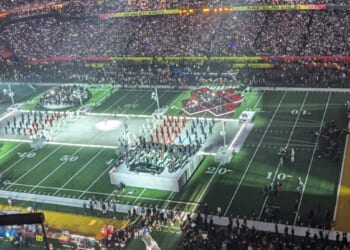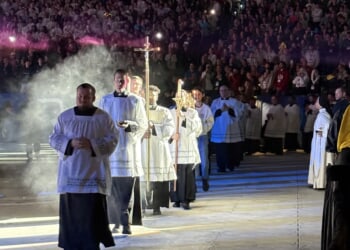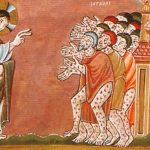There is a distinction made in theology between the Church as visible society (societas) and the Church as spiritual communion (communio) of saints in heaven and on earth. The union of soul and body serves as an analogy.
The Church, however, is often reduced to Her outer, visible dimensions as demonstrated in the recent movie, Conclave. There, “the Church” is equated with an unflattering view of the hierarchy wherein bishops and cardinals vie for positions of power and influence (a view leading Martin Luther in the 16th century to label the Church as “the whore of Babylon”). But this fails to consider the inner, spiritual reality of the Church as Holy Communion (communio) into which men and women are initiated by Baptism, from which they are sent on mission through Confirmation, and by which they are fed in the Eucharist. The Church is Holy Communion instituted by Christ, in time, granting a share in the Communion of God, Father, Son, and Holy Spirit, in eternity.
St. Therese of Lisieux, doctor scientiae amoris, learned this truth when she discovered her vocation to be love, declaring in her autobiography, The Story of a Soul: “In the heart of the Church, my Mother, I will be love.” This is the “narrow gate” (Mt. 7:13) through which Christ calls us to enter, namely, love “in the heart of the Church.”
St. Therese’s life witnesses to love in the heart of the Church, a vocation further refined by suffering as a share in the cross of Christ. She persevered in love amid suffering by joyfully drawing water “from the fountains of salvation” (Is. 12:3), which she discovered in the Trinitarian communion of love at the heart of the Church and imparted by blood and water flowing from the side of Christ upon the cross (cf. Jn. 19:34). The “gate” narrows further, therefore, considering that St. Therese persevered in love “in the heart of the Church” when in our day the road is wide leading men and women to leave the Church.
It is the purpose of this essay to briefly meditate on how the Church is not a hindrance to love, but the very condition for its preservation and growth. The theme for this essay begins with Revelation 12:13, 15-17 which reads:
When the dragon saw that it had been thrown down to the earth, it pursued the woman who had given birth to the male child…The serpent, however, spewed a torrent of water out of his mouth after the woman to sweep her away with the current. But the earth helped the woman and opened its mouth and swallowed the flood that the dragon spewed out of its mouth. Then the dragon became angry with the woman and went off to wage war against the rest of her offspring, those who keep God’s commandments and bear witness to Jesus.
The woman in the story symbolizes both Mary, the Mother of God, and the Church, the two being interchangeable according to St. Francis of Assisi. In The Salutation of the Blessed Virgin Mary, St. Francis referred to Mary as “the virgin made Church,” which St. Maximillian Kolbe would later interpret to mean that Mary is in herself what the Church is in many.
In the above text, “the serpent spewed a torrent of water out of his mouth after the woman to sweep her away with the current.” This torrent was what Christ contended with on Calvary. Jesus faced down the torrents of hell thrown against Him from the mouth of the dragon and the agency of secondary causes (other human beings) as He mounted Calvary.
Revelation 12 states that “the earth helped the woman and opened its mouth and swallowed the flood that the dragon spewed out of its mouth,” symbolizing the humanity of Christ on the cross which absorbed the full torrents of hell in a dramatic wrestling match that ended with the dragon, or Satan, being vanquished in the resurrection. The Song of Songs foretold this brave deed of Christ declaring love to be “strong as Death” and longing as “fierce as the nether world…Deep waters cannot quench love, nor rivers sweep it away” (8:6-7).
“The woman” escapes as a result, and she symbolizes both Mary, whose Immaculate Conception and bodily Assumption were ensured by the redemptive sacrifice of Christ on the cross, and the Church, some of whose members have already joined Mary in paradise.
But Revelation 12 continues, telling how “the dragon became angry with the woman and went off to wage war against the rest of her offspring, those who keep God’s commandments and bear witness to Jesus.” These are the offspring of the Church still on earth who are reborn in Baptism, sent on mission through Confirmation, and nursed “with delight at her abundant breasts” (Is. 66:11) in the Eucharist.
This is us. We, too, face down the torrents of hell spewed out by the mouth of the dragon, but the torrent is now mitigated by Christ crucified and risen for all who remain in Christ as members of His Body, the Church.
We are all going to suffer, but not everyone will persevere in love in the midst of their suffering. The gate is narrow and constricted, and “those who find it are few” (Mt. 7:14), especially when we consider how membership in the Church is a pivotal precondition for persevering in love. Jesus did not say to Peter, “All the others are doomed, but against you the gates of hell shall not prevail.” No, Jesus spoke of the Church prevailing and not Peter alone. He said to Simon, “You are Peter, and upon this rock I will build my church, and the gates of the netherworld shall not prevail against it” (Mt. 16:18). It is the Church that prevails. We do not persevere in love in the midst of suffering on our own but through our membership in the Body of Christ wherein, like St. Therese, we drink deeply of the indominable love of Trinitarian communion at the heart of the Church.
Do we hope to persevere in love in the midst of suffering solely on the basis of our resources alone, or have we possibly even become indifferent to growing in love altogether?
“What king marching into battle would not first sit down and decide whether with ten thousand troops he can successfully oppose another king advancing upon him with twenty thousand troops? But if not, while he is still far away, he will send a delegation to ask for peace terms.” (Lk. 14:31-32)
We have people today seeking peace terms with the dragon and secondary causes of evil—other human beings—who outgun them, because the road is wide leading men and women to leave the Church. In leaving, however, they fall out of communion with Christ and His love at the heart of the Church. It is this love that changes a confession line from a line of shame into a line of courage made up of men and women who refuse to give up. Instead, they seek to drink deeply once again of the indominable love of Trinitarian communion laid down by Christ at the heart of the Church and so revive and persevere in love, even in the midst of suffering.
This is the “narrow gate” leading to life, a life once stolen from us by the serpent but now restored to us by Christ and His Church.
Photo by Dylan Freedom on Unsplash












